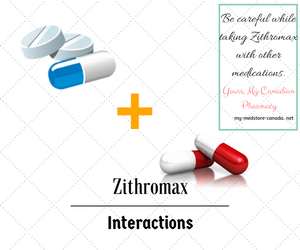Zithromax Interactions with Other Drugs
[ithshop code=”zithromax” tpl=”short” page_id=”282″ dummy=”txt”]Each medication has its own interactions as well as Zithromax. Interactions of this preparation are diverse so that we will try to clear out this issue.
Interactions
Zithromax with food interaction reduces azithromycin absorption.
Antacids: antacids slow down azithromycin absorption. The recommended interval between taking drug and antacids is at least two hours.
Cetirizine: simultaneous interaction with cetirizine in 20 mg dosage for 5 days in healthy patients did not change or significant change pharmacokinetics of QT interval.
Didanosine: simultaneous administration at a daily dose and 1200 mg of didanosine in 6 subjects did not affect the pharmacokinetics of didanosine compared to placebo.
Digoxin: since there is evidence of change in digoxin metabolism in patients who are taking macrolide antibiotics, in case of simultaneous administration should be taken with caution.
Zidovudine: a single application in a dose of 1000 mg and multiple doses of 1200 mg had no effect on pharmacokinetics, as well as the allocation of zidovudine and its metabolites.
 Ergotamine derivatives: Because of the theoretical possibility of ergotism manifestation Zithromax should not be used together with ergotamine derivatives.
Ergotamine derivatives: Because of the theoretical possibility of ergotism manifestation Zithromax should not be used together with ergotamine derivatives.
Atorvastatin: while the use of atorvastatin (10 mg daily) and erythromycin (500 mg daily), the later had no effect on the concentration of atorvastatin in plasma.
Carbamazepine: In a pharmacokinetic study conducted in healthy volunteers, this antibiotic had no significant effect on levels of carbamazepine or its active metabolite in plasma.
Cimetidine: cimetidine when taking two hours before its application, changes were not observed in this antibiotic pharmacokinetics.
Coumarin Oral anticoagulants: in pharmacokinetic interaction study, Zithromax interaction with warfarin is not altered when receiving a dose of 15 mg in healthy patients. After co-administration of erythromycin and coumarin anticoagulants produce an anticoagulant effect. Although a causal relationship has not been established, you should consider the frequency of prothrombin time testing when Zithromax is taken by patients.
Cyclosporine: Some macrolide antibiotics perform on cyclosporine metabolism. At the same time taking Zithromax and cyclosporine, it is necessary to control cyclosporine concentration.
Efavirenz: co-administration of a single dose of azithromycin 600 mg and 400 mg efavirenz daily for 7 days did not result in clinically significant pharmacokinetic interaction.
Fluconazole: Concomitant use of a single dose of 1200 mg did not alter the pharmacokinetics of single dose of 800 mg fluconazole. Total concentration and elimination, Zithromax half-life has not changed, while fluconazole use. However, it was observed a clinically significant decrease in Cmax (18%) of azithromycin.
Indinavir: simultaneous use of a single dose of 1200 mg had no significant effect on the pharmacokinetics of indinavir when receiving a dose of 800 mg three times a day for 5 days.
Methylprednisolone: pharmacokinetic drug interactions study in healthy patients, Zithromax had no significant effect on the pharmacokinetics of methylprednisolone.
Midazolam: healthy patients taking simultaneously 500 mg daily for 3 days do not notice any clinically significant changes in pharmacokinetics and pharmacodynamics of midazolam once when receiving 15 mg.
Nelfinavir: simultaneous administration of azithromycin (1200 mg) and nelfinavir (750 mg) increases a concentration of azithromycin. There were observed no clinically significant side effects. There is no need to adjust the dose.
Rifabutin: simultaneous administration of Zithromax and rifabutin concentration had no effect on any of the two drugs in serum. With simultaneous use of these two substances, neutropenia was observed in patients. Neutropenia is associated with the use of rifabutin, causal relationship, when taken in combination with azithromycin, has not been established.
Zithromax interaction with sildenafil: it found no evidence for an effect (for taking 500 mg daily for 3 days) for AUC and Cmax values of sildenafil or its major metabolites in blood.
Terfenadine: it is not revealed the interaction of terfenadine and Zithromax. In some cases, such interaction cannot be avoided. Yet there is no evidence of such a reaction. As with other macrolides, these two substances application should be carried out with caution.
Theophylline: Azithromycin has no effect on the pharmacokinetics of theophylline in healthy patients. Simultaneous use of theophylline and other macrolide antibiotics sometimes leads to increase in theophylline concentration in serum.
Triazole: a simultaneous application 500 mg on Day 1 and 250 mg on Day 2 and 0.125 mg triazole on Day 2 in 14 healthy subjects, there is no significant effect on pharmacokinetic parameters of triazole compared to simultaneous reception of triazole and placebo.
Trimethoprim/sulfamethoxazole: concomitant use of trimethoprim/sulfamethoxazole DS (160 mg / 800 mg) during 7 days, and 1200 mg on day 7 had no significant effect on peak concentrations, total exposure or elimination of trimethoprim and sulfamethoxazole.







